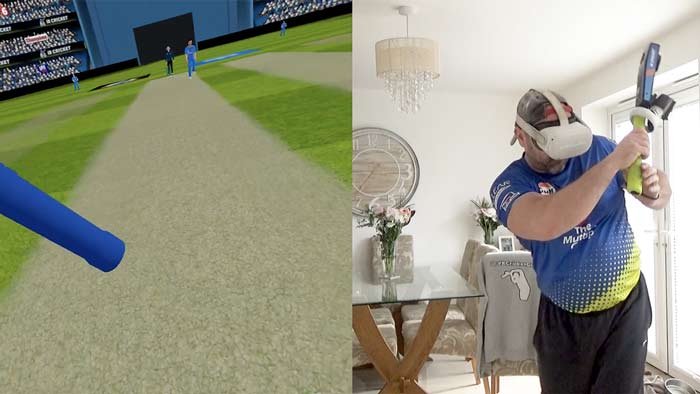Welcome back, VR cricket fans! Today, we’re diving into the fascinating world of virtual reality (VR) to understand how this incredible technology actually works. Whether you’re smashing sixes in VR cricket or exploring immersive virtual worlds, understanding the mechanics behind VR can enhance your gaming experience.
- Get the epic new Asgard’s Wrath 2 included (a £44.99 value) when you buy Meta Quest 3 128 GB.
- Dive into extraordinary experiences with a mixed reality headset that transforms your home into an exciting new playgrou…
- It’s the most powerful Quest yet*, featuring next-level performance with more than double the graphic processing power o…

Let’s explore the nuts and bolts of VR, with a special focus on Meta Quest VR headsets.
What is Virtual Reality?
Virtual reality is a technology that creates a simulated environment that can be similar to or completely different from the real world. Using VR headsets, users can immerse themselves in 3D environments, interact with virtual objects, and experience a sense of presence in the digital world.
Components of a VR System
1. Head-Mounted Display (HMD)
The head-mounted display is the cornerstone of any VR system. The Meta Quest VR headsets, such as the Meta Quest 2, are prime examples of advanced HMDs. These devices contain two small screens positioned in front of the eyes, displaying slightly different images to create a stereoscopic 3D effect.
- Screens and Lenses: The screens provide high-resolution visuals, while the lenses adjust these images to create a sense of depth. The Meta Quest 2, for instance, offers a resolution of 1832 x 1920 pixels per eye, ensuring crisp and clear visuals.
2. Motion Tracking Sensors
Motion tracking is crucial for an immersive VR experience. These sensors track the position and orientation of your head and body, allowing the virtual environment to adjust in real-time as you move.
- Inside-Out Tracking: The Meta Quest VR headsets utilize inside-out tracking with built-in cameras, eliminating the need for external sensors. This technology tracks your movements by mapping your surroundings and adjusting the virtual environment accordingly.
3. Controllers
VR controllers are used to interact with the virtual environment. They often include buttons, triggers, and joysticks, as well as motion-sensing capabilities. The Meta Quest 2 comes with Touch Controllers that offer precise hand tracking and haptic feedback, enhancing the realism of your interactions.
4. Software
VR software includes the games and applications you use. These programs are designed to take advantage of VR hardware, offering experiences that range from simple simulations to complex, interactive worlds. In VR cricket, for example, the software simulates a cricket field, allowing you to bat, bowl, and field as if you were on a real pitch.
How VR Works

1. Display Technology
VR headsets use stereoscopic displays to create a sense of depth. Each eye sees a slightly different image, similar to how our eyes perceive the real world. The lenses in the headset adjust these images to align correctly, creating a 3D effect.
2. Motion Tracking
Motion tracking ensures that the virtual environment responds accurately to your movements. The Meta Quest 2’s inside-out tracking system uses multiple cameras on the headset to map your physical space and track your movements, allowing you to move freely within your play area.
3. Field of View (FOV)
The field of view is the extent of the observable world at any given moment. A wider FOV enhances the immersive experience by allowing you to see more of the virtual environment. The Meta Quest 2 offers a FOV of about 90 degrees, which provides a broad and immersive view.
4. Sound
Sound plays a crucial role in VR immersion. 3D audio technology makes sounds appear to come from specific directions, adding to the realism of the experience. The Meta Quest 2 includes spatial audio capabilities, which means you can hear sounds coming from all around you, enhancing the sense of presence.
5. Interaction
Interaction in VR is facilitated through controllers and motion tracking. For example, in VR cricket, you can use the Touch Controllers to mimic the actions of batting and bowling. The precise tracking ensures that your in-game actions match your real-world movements, making the experience more immersive.
Enhancing Your VR Cricket Experience
Here are a few tips to get the most out of your VR cricket sessions:
- Proper Calibration: Ensure your VR headset and play area are properly calibrated to avoid motion sickness and ensure accurate tracking.
- Use Quality Equipment: Invest in a good VR headset like the Meta Quest 2 and compatible accessories for the best experience.
- Explore Different Games: Try different VR cricket games to find the ones that offer the most realistic and enjoyable experience.
Conclusion
Virtual reality works by combining advanced display technology, motion tracking, and interactive software to create immersive 3D environments. Understanding the mechanics behind VR can enhance your appreciation of VR cricket games and improve your overall experience. With Meta Quest VR headsets, you can dive into the world of VR with cutting-edge technology that offers unparalleled immersion and realism.
Ready to step up your VR cricket game? Check out the latest Meta Quest VR headsets and accessories on Amazon.
For more detailed information on virtual reality technology, you can visit HowStuffWorks and TechRadar.
Happy gaming, and see you on the virtual pitch!

Pingback: Will Jacks: IPL Experience is Ideal Prep for T20 World Cup - VR Cricket Guy
Pingback: BBC Secures New Four-Year Deal with ICC: A Golden Era for Cricket Audio Broadcasting - VR Cricket Guy
Pingback: Mint3D VR Cricket Bat Discount Code - VR Cricket Guy